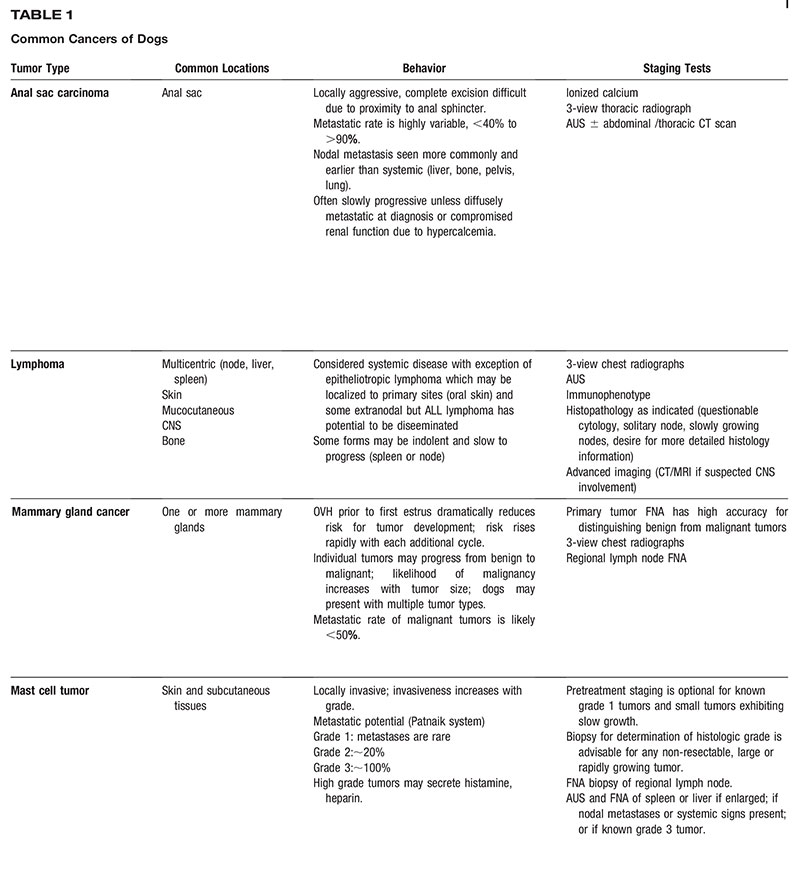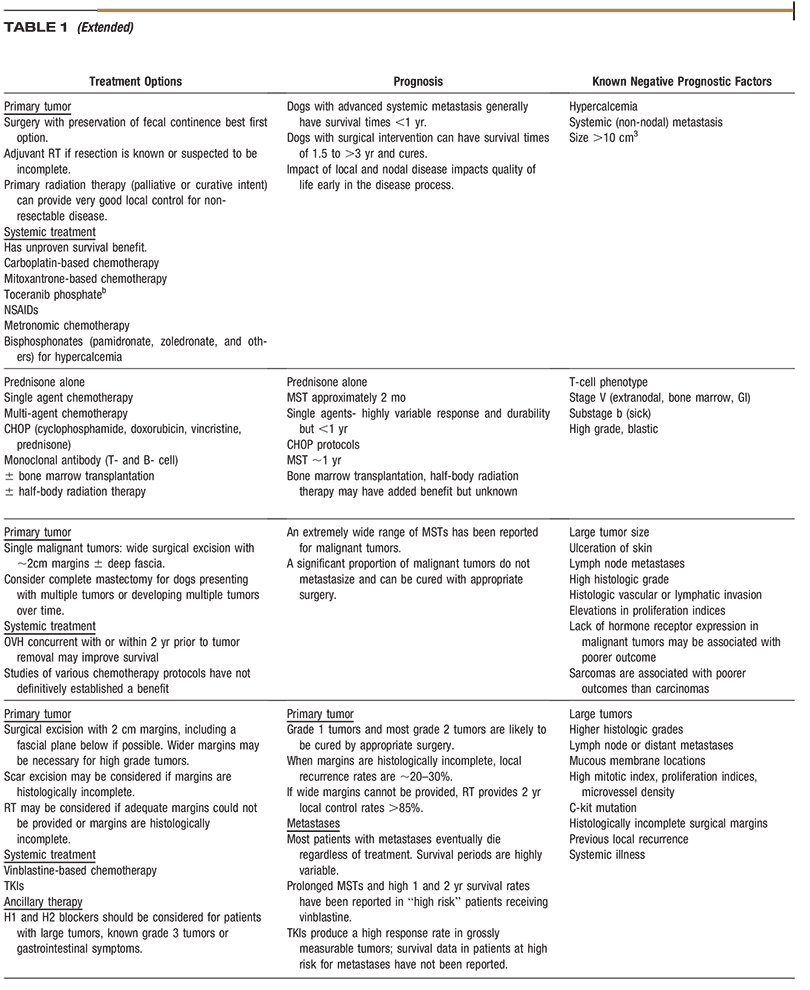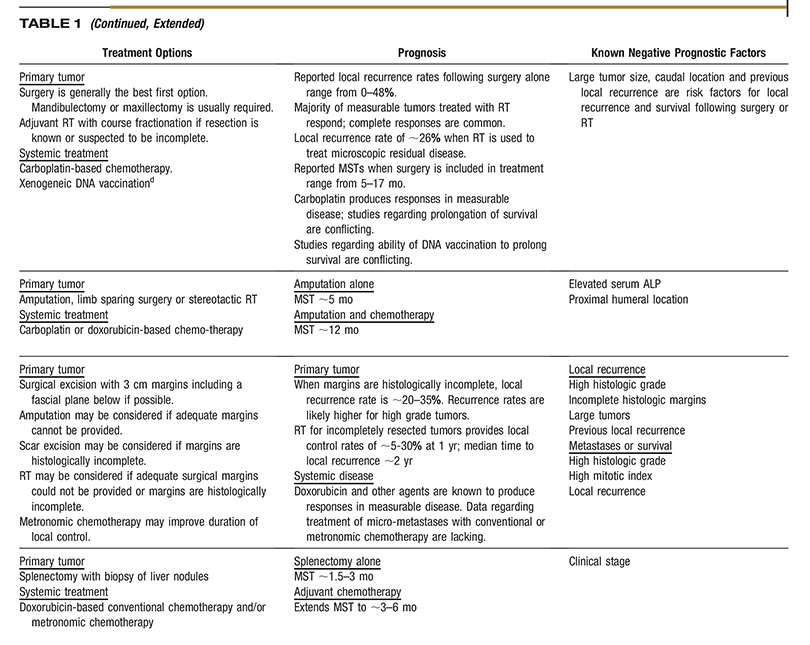Diagnosis of Tumor Type
Cytology provides information based on the microscopic appearance of individual cells. Fine-needle sampling, which may or may not involve aspiration, can be performed safely for themajority of external tumors, without sedation or anesthesia. When performing fine-needle sampling, aspiration is useful when the tissue is firm and may be of mesenchymal origin, but collecting samples without aspiration can often result inmore diagnostic samples and lead to less blood contamination for soft tissue masses of round cell origin. Internal tumors can be sampled with ultrasound guidance depending on location, ultrasound appearance, and size. Cytology can often provide a definitive diagnosis of round cell tumors, and can be helpful in categorizing other tumors as mesenchymal or epithelial. With training and experience, the general practitioner can often determine the presence and type of neoplasia in the office. Submission to a clinical pathologist for diagnostic confirmation is usually indicated prior to therapy. Cytology does not provide tumor grade information and may not always provide a clear-cut diagnostic result due to poor sampling technique or the tumor type.
Cytology provides information based on the microscopic appearance of individual cells. Fine-needle sampling, which may or may not involve aspiration, can be performed safely for themajority of external tumors, without sedation or anesthesia. When performing fine-needle sampling, aspiration is useful when the tissue is firm and may be of mesenchymal origin, but collecting samples without aspiration can often result inmore diagnostic samples and lead to less blood contamination for soft tissue masses of round cell origin. Internal tumors can be sampled with ultrasound guidance depending on location, ultrasound appearance, and size. Cytology can often provide a definitive diagnosis of round cell tumors, and can be helpful in categorizing other tumors as mesenchymal or epithelial. With training and experience, the general practitioner can often determine the presence and type of neoplasia in the office. Submission to a clinical pathologist for diagnostic confirmation is usually indicated prior to therapy. Cytology does not provide tumor grade information and may not always provide a clear-cut diagnostic result due to poor sampling technique or the tumor type.
The goal of histopathology is to provide a definitive diagnosis when unobtainable by cytology. Histopathology provides information on tissue structure, architectural relationships, and tumor grade—results that are not possible with cytology. The histologic tumor grade may guide the choice of treatment and provide prognostic information. Proper technique is critical when performing a surgical biopsy, particularly to obtain an adequate diagnostic sample and to prevent seeding of the cancer in adjacent normal tissues.
Basic biopsy principles include the following:
- Obtain multiple samples from multiple locations within the tumor.
- Biopsy deeply enough to penetrate any overlying normal or reactive tissue.
- Handle biopsy specimens gently.
- Place samples in an adequate amount of formalin (10 parts formalin to 1 part tissue).
- To avoid seeding adjacent normal tissue with cancer cells, place the biopsy incision so that it can easily be excised at the time of definitive tumor removal.
- Excisional biopsy (i.e., removal of a tumor without prior knowledge of the tumor’s histologic type) may be appropriate if (1) principles of appropriate surgical excision of tumors are followed; and (2) staging procedures that might influence the owner’s decision to have an excision performed have been completed.



Ancillary tests can provide or confirm a diagnosis when routine histopathology does not yield definitive results. Tests such as immunohistochemistry, proliferation markers, special tissue stains, polymerase chain reaction, polymerase chain reaction for antigen receptor rearrangement (in this case for lymphoma), and flow cytometry can provide additional prognostic information or identify potential therapeutic targets. Communication with a pathologist or oncology specialist can be useful for identifying which ancillary tests may be indicated, how to perform them, and how they might be beneficial. Knowledge of the lymphocyte phenotype sometimes affects the treatment choice. For example, identification of a T-cell phenotype lymphoma generally indicates a poor or guarded prognosis, making the patient a candidate for any of several therapies that may differ from those typically used for a B-cell lymphoma. Immunohistochemistry, polymerase chain reaction for antigen receptor rearrangement, and flow cytometry can all be used to determine if a patient with enlarged lymph nodes has lymphoma versus a reactive process when an ambiguous cytology or histopathology report is obtained. However, which test to choose depends on the individual case.




